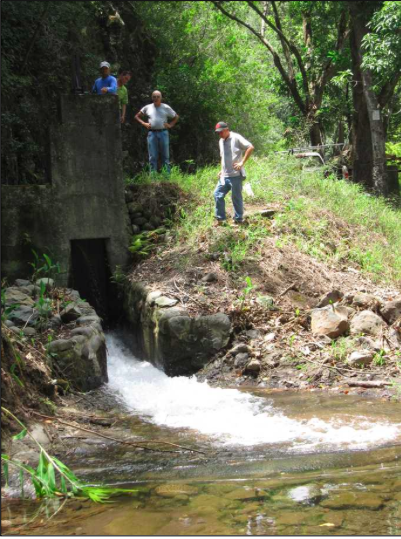At the Commission on Water Resource Management’s August 16 meeting, Hokuao Pellegrino of the non-profit Hui o Na Wai Eha was one of the many testifiers who asserted that the agency was unfairly targeting John and Rose Marie Duey for the pipe they had installed in the Wailuku River more than a decade ago after a neighbor allegedly bulldozed the ancient Hawaiian auwai that once served their land. The commission chose that day to refrain from fining the couple, but not before Pellegrino announced that his organization would be filing complaints regarding the commission’s failure to enforce interim instream flow standards (IIFS) for Wailuku and Waihe`e Rivers and Waikapu stream agreed to in an April 2014 settlement.
Pellegrino complained that Wailuku Water Company (WWC), which operates much of the ditch system that diverts the streams, took more than six months to implement the IIFS, when it had originally stated it would take two months at most. He claimed that the company restored only a fraction of the 2.9 million gallons a day (mgd) designated for Waikapu Stream and the 10 mgd for the Wailuku River.
Pellegrino testified that the WWC and Hawaiian Commercial & Sugar (HC&S) had also failed to provide enough water to ensure a steady flow from the mountain to the sea, a standard required under the settlement. Despite asking the commission to act, nothing was rectified for more than five months, he said.
“The commission did not impose any fines for HC&S to weld two plates that took less than a week. And the failures to comply with the settlement continue, he argued, citing commission monitoring reports, which he said show that from January through April, WWC has again failed to provide 10 mgd to Wailuku River.
Pellegrino also complained about the commission’s spotty monitoring and lack of data to determine whether the IIFS are being met. He touted the U.S. Geological Survey’s stream gages, which provide information in real time that “you can check on your phone, your computer.”
Commission staff is currently getting its stream data from pressure transducers that are checked in-person periodically.
“The trend since 2014, pressure transducers are only read every four months. If they [WWC and HC&S] aren’t complying, we won’t know for four months,” Pellegrino complained. With regard to Waihe`e River, there has been no reporting since 2010, he said.
Pellegrino added that a ruler bolted to the Wailuku River allows anyone to see how much water is flowing, but WWC has denied public access to it.
Commission chair Suzanne Case said the agency can’t afford to install install expensive stream gages right now. Uyeno told Environment Hawai`i that USGS gages cost about $21,000 apiece and “there are budgetary and physical limits to what the USGS is capable of.”
“We stand by our current gaging efforts, but what needs to be discussed and developed internally is an enforcement policy and enhanced monitoring efforts that are not so costly (and can be funded and maintained by diverters),” he added.
As of press time, the commission had not received the aforementioned complaints from Pellegrino or the Hui.
— Teresa Dawson


Leave a Reply